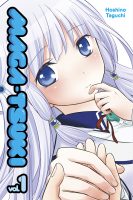My News and Reviews
Last week I posted the Bookshelf Overload for May, a rather lengthy list of manga, comics, and other books that have recently made their way into my home. One reason it was such a long was due to the fact that the Toronto Comic Arts Festival was also held in May and I’m always inspired to pick up a bunch of things while I’m there. Normally I post the Bookshelf Overload feature during the second week of the month rather than the third, but I switched things up this time in order to post my review of Yeon-sik Hong’s manhwa Uncomfortabily Happily closer to its release date.
Elsewhere online, Deb Aoki recently took a look at some of the major trends impacting the North American manga industry for Publishers Weekly–“Nine Reasons Manga Publishers Can Smile in 2017.” Otherwise, I didn’t really come across much in the way of manga news and announcements last week. While it may have in fact been a relatively quiet week, I suspect that I might have just missed things due to the fact that I wasn’t online much. (I’m in the midst of preparing lesson plans for an introduction to taiko course that I’ll be instructing over the summer.) Do let me know if there was anything in particular that you’ve found interesting lately, though!
Quick Takes
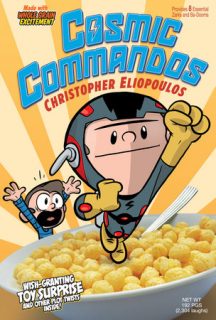 Cosmic Commandos by Chris Eliopoulos. Every once in a while a comic is directly sent my way that I otherwise would probably have never encountered. Cosmic Commandos, the debut graphic novel of American comics creator and illustrator Eliopoulos, is one such work. In part inspired by his own identical twin sons, Cosmic Commandos follows an unexpected adventure that a pair of twin brothers find themselves caught up in. Jeremy and his (slightly) younger brother Justin have vastly different personalities, much to Jeremy’s dismay and embarrassment. In fact, Jeremy seems pretty annoyed and bored with a lot in his life, but that soon changes when a cereal box prize turns him into the hero from his favorite video game. Not only that, the monsters and villains from the game are now invading the town, too. However, they are proving to be much more difficult to beat in real life and, like it or not, Jeremy will need to rely on Justin’s help to save the day. Cosmic Commandos is aimed towards younger readers but some of the more subtle jokes and humor will probably be appreciated even more by the adults in their lives. It’s not a comic that I would normally find myself reading, but it was a fun and energetic story. There’s even a sequel in the works, Monster Mayhem, which sounds delightful.
Cosmic Commandos by Chris Eliopoulos. Every once in a while a comic is directly sent my way that I otherwise would probably have never encountered. Cosmic Commandos, the debut graphic novel of American comics creator and illustrator Eliopoulos, is one such work. In part inspired by his own identical twin sons, Cosmic Commandos follows an unexpected adventure that a pair of twin brothers find themselves caught up in. Jeremy and his (slightly) younger brother Justin have vastly different personalities, much to Jeremy’s dismay and embarrassment. In fact, Jeremy seems pretty annoyed and bored with a lot in his life, but that soon changes when a cereal box prize turns him into the hero from his favorite video game. Not only that, the monsters and villains from the game are now invading the town, too. However, they are proving to be much more difficult to beat in real life and, like it or not, Jeremy will need to rely on Justin’s help to save the day. Cosmic Commandos is aimed towards younger readers but some of the more subtle jokes and humor will probably be appreciated even more by the adults in their lives. It’s not a comic that I would normally find myself reading, but it was a fun and energetic story. There’s even a sequel in the works, Monster Mayhem, which sounds delightful.
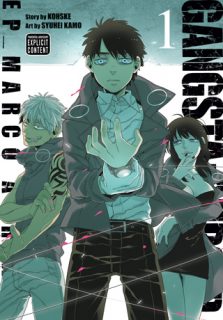 Gangsta: Cursed, Volumes 1-2 written by Kohske and illustrated by Syuhei Kamo. I was surprised and impressed by how close Kamo’s artwork in Gangsta: Cursed aligns with Kohske’s artwork in Gangsta. This can probably be largely explained by the fact that Kamo is actually one of Kohske’s assistants for the original series, of which I wasn’t previously aware. Gangsta: Cursed primarily takes place before the events of the main series and is set during another time in Ergastulum’s history in which violence against the Twilight population was at a peak. Although there hasn’t been much story yet per se–for the most part the first two volumes of Gangsta: Cursed consist of one brutal action sequence after another–functionally the series serves as the backstory for Marco Adriano, who at that point was known as Spas. Unsurprisingly, considering that this is still Gangsta, his past is a tragic one filled blood and death. Indoctrinated as a young man to hate Twilights above all else, he is part of a group of particularly vicious Hunters known as the Destroyers. They have been instructed to kill all of the Twilights that they can find along with any normal human sympathizers, and they do. However, Spas is beginning to have doubts and seems to be quickly approaching a psychological breakdown.
Gangsta: Cursed, Volumes 1-2 written by Kohske and illustrated by Syuhei Kamo. I was surprised and impressed by how close Kamo’s artwork in Gangsta: Cursed aligns with Kohske’s artwork in Gangsta. This can probably be largely explained by the fact that Kamo is actually one of Kohske’s assistants for the original series, of which I wasn’t previously aware. Gangsta: Cursed primarily takes place before the events of the main series and is set during another time in Ergastulum’s history in which violence against the Twilight population was at a peak. Although there hasn’t been much story yet per se–for the most part the first two volumes of Gangsta: Cursed consist of one brutal action sequence after another–functionally the series serves as the backstory for Marco Adriano, who at that point was known as Spas. Unsurprisingly, considering that this is still Gangsta, his past is a tragic one filled blood and death. Indoctrinated as a young man to hate Twilights above all else, he is part of a group of particularly vicious Hunters known as the Destroyers. They have been instructed to kill all of the Twilights that they can find along with any normal human sympathizers, and they do. However, Spas is beginning to have doubts and seems to be quickly approaching a psychological breakdown.
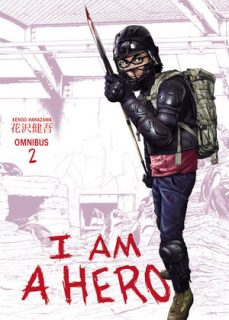 I Am a Hero, Omnibuses 2-3 (equivalent to Volumes 3-6) by Kengo Hanazawa. I’ll have to admit, although in general I’ve grown somewhat weary of the zombie subgenre, I’m finding I Am a Hero to be a gripping series. It can also be fairly gruesome and outright disturbing at times. Hanazawa has at this point established a good narrative rhythm, allowing both the characters and readers to have moments of respite (even if those moments are still frequently anxiety-inducing) in between intense, action-oriented, near-death experiences. Hideo, the lead of I Am a Hero, continues to be one of the most interesting characters that I’ve recently encountered in a manga, mostly due to the non-sensationalistic portrayal of the numerous mental health issues he deals with on top of simply trying to survive a zombie outbreak. Most everyone he knows has already died or has otherwise succumbed to the devastating infection, but as the series progresses further he does at least temporarily find some allies who can confirm that something terrible is going on in the world and that it’s not just all in his head. How long any of them will last is an entirely different matter though; the death count in I Am a Hero continues to be incredibly high and any survivors aren’t having an easy time of it, either.
I Am a Hero, Omnibuses 2-3 (equivalent to Volumes 3-6) by Kengo Hanazawa. I’ll have to admit, although in general I’ve grown somewhat weary of the zombie subgenre, I’m finding I Am a Hero to be a gripping series. It can also be fairly gruesome and outright disturbing at times. Hanazawa has at this point established a good narrative rhythm, allowing both the characters and readers to have moments of respite (even if those moments are still frequently anxiety-inducing) in between intense, action-oriented, near-death experiences. Hideo, the lead of I Am a Hero, continues to be one of the most interesting characters that I’ve recently encountered in a manga, mostly due to the non-sensationalistic portrayal of the numerous mental health issues he deals with on top of simply trying to survive a zombie outbreak. Most everyone he knows has already died or has otherwise succumbed to the devastating infection, but as the series progresses further he does at least temporarily find some allies who can confirm that something terrible is going on in the world and that it’s not just all in his head. How long any of them will last is an entirely different matter though; the death count in I Am a Hero continues to be incredibly high and any survivors aren’t having an easy time of it, either.
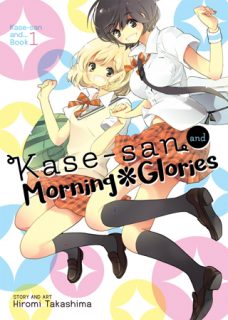 Kase-san and Morning Glories by Hiromi Takashima. I haven’t quite been able to put my finger on exactly why, but I find the cover art of the first volume in the Kase-san series to be both cute and slightly off-putting. Fortunately, later volumes don’t seem to have the same issue. It’s also somewhat misleading as the interior illustrations are drawn in a completely different style, but one that I greatly prefer even though the anatomy can occasionally be a bit off. Like many manga, Kase-san and Morning Glories originally started as a one-shot story which is probably why the early part of the series feels very episodic. I’m not sure if the episodic nature of the manga will continue or if the series will develop a larger overarching narrative (which by the end of the first volume it seems that it might), but what I am certain of is that Kase-san and Morning Glories is adorable, light, and fluffy. There’s not much depth to the characters or stories at this point, but they are likeable and charming. The manga is largely seen from the perspective of Yamada, a young woman who loves to garden and who has recently found herself attracted to the titular Kase, one of the tomboyish stars of their school’s track team. Kase likes Yamada, too, but it takes some time for them to realize that their feelings are mutual.
Kase-san and Morning Glories by Hiromi Takashima. I haven’t quite been able to put my finger on exactly why, but I find the cover art of the first volume in the Kase-san series to be both cute and slightly off-putting. Fortunately, later volumes don’t seem to have the same issue. It’s also somewhat misleading as the interior illustrations are drawn in a completely different style, but one that I greatly prefer even though the anatomy can occasionally be a bit off. Like many manga, Kase-san and Morning Glories originally started as a one-shot story which is probably why the early part of the series feels very episodic. I’m not sure if the episodic nature of the manga will continue or if the series will develop a larger overarching narrative (which by the end of the first volume it seems that it might), but what I am certain of is that Kase-san and Morning Glories is adorable, light, and fluffy. There’s not much depth to the characters or stories at this point, but they are likeable and charming. The manga is largely seen from the perspective of Yamada, a young woman who loves to garden and who has recently found herself attracted to the titular Kase, one of the tomboyish stars of their school’s track team. Kase likes Yamada, too, but it takes some time for them to realize that their feelings are mutual.


